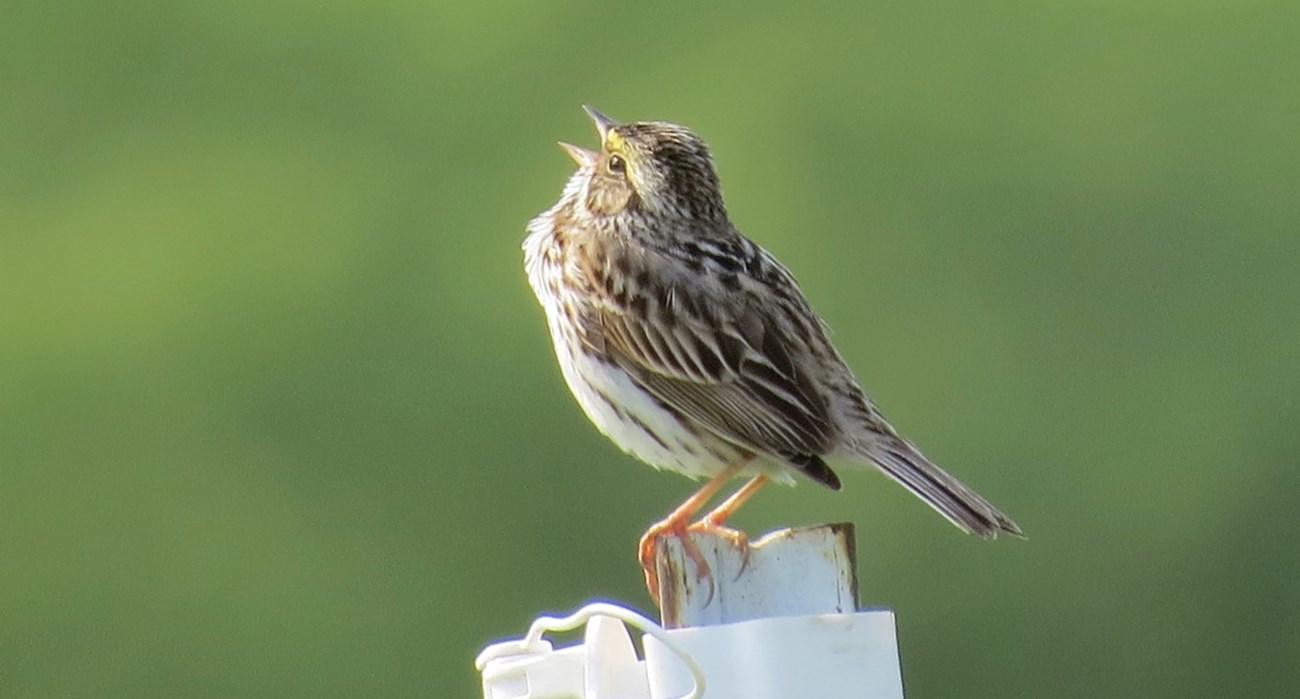
Jay Dia Minute Man National Historical Park offers excellent opportunities for birdwatching! The variety of landscapes within the park's 1000 plus acres provide prime nesting habitat, plentiful food sources, and ideal pit-stops for migratory birds. With more than 160 species spending at least some time in the park and 50 species known to breed here, you can always find a feathered friend along the trail. Keep scrolling to learn more about a few favorite species. Featured FriendsMeet some of the common birds seen in Minute Man National Historical Park 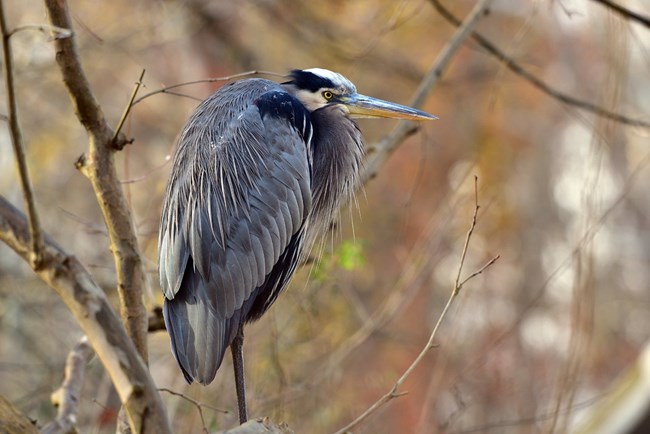
NPS photo Great Blue HeronArdea herodiasA spring, summer and fall resident of Minute Man National Historical Park, the Great Blue Heron can often be spotted fishing in the Concord River or sunning itself by the North Bridge. This bird is easy to spot, as it is the largest of the North American heron species, measuring up to 53 inches tall with a wingspan of over 6 and a half feet! It also has a distinctive “S” shaped neck and knobby orange knees. Herons will make their home in fresh or saltwater marshlands but will head to grassy areas and farm fields to forage for food. These birds can thrive in a number of habitats from lakeshores in Northern Maine, to the mangroves of South Florida and even along the coast of Southeast Alaska! Because of the Great Blue can make a home almost anywhere, it has adapted to a pretty diverse diet; eating fish, frogs, rodents, bird and bugs. Mama herons will typically lay 3-5 eggs once a year, but sometimes you might just find 7 eggs in their large, tree-bound stick platforms that serve as nests. Both male and female birds feed the young after they’ve hatched. Baby Great Blues can fly about 2 months after birth and will fledge about a month following that. These harsh squawking birds are doing well in North America, their population stable, and with the warming climate, have expanded their range into Canada. 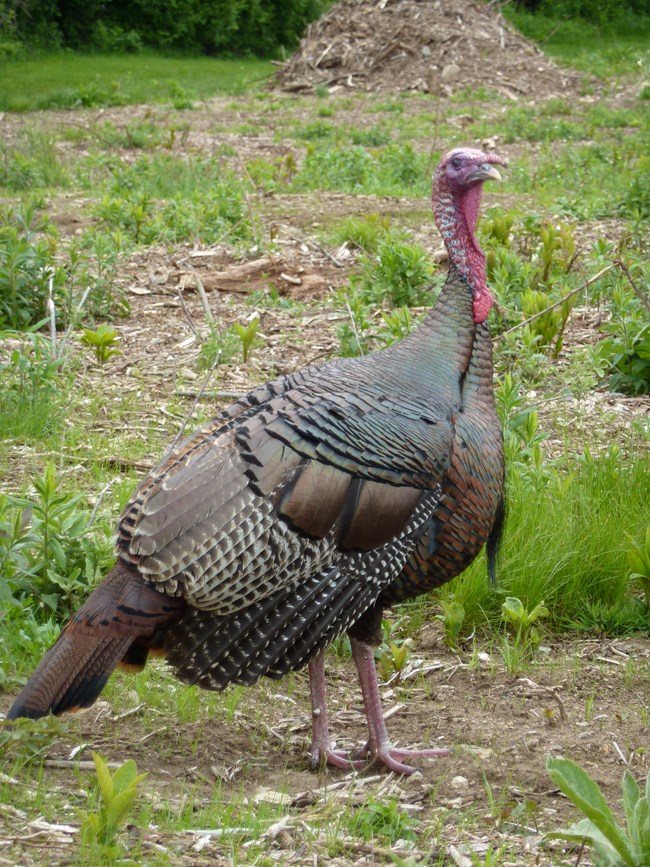
Jay Dia Wild TurkeyMeleagris gallopavoWhile Ben Franklin never actually proposed the turkey be named the national bird, in a letter to his daughter Sarah, he did praise the fowl as courageous and a “true original native of America”. Despite the love of a founding father, the Wild Turkey actually went extinct in Massachusetts in the mid-19th century. In the 1970’s the Division of Fisheries and Wildlife reintroduced 37 turkeys to the Bay State and today the population is more than 20,000. These members of the pheasant family like to hang out near the Minute Man Visitor Center in Lexington, but don’t approach them or you might find 4 feet and 20lbs of feathers zooming toward you. Turkeys can fly more than 50 mph for short distances and will nest in trees. These birds make their home in a variety of woodland areas, feeding on grasses, roots, berries, seeds, insects and sometimes small amphibians and reptiles like salamanders. Male turkeys breed with a number of females each season and each female will lay roughly 10 eggs. A baby turkey is called a poult, and sticks with its mom for just a few months before courageously taking on the wide world. For more information on the Turkey, click here for a great Species Spotlight from the Northeast Temperate Network. 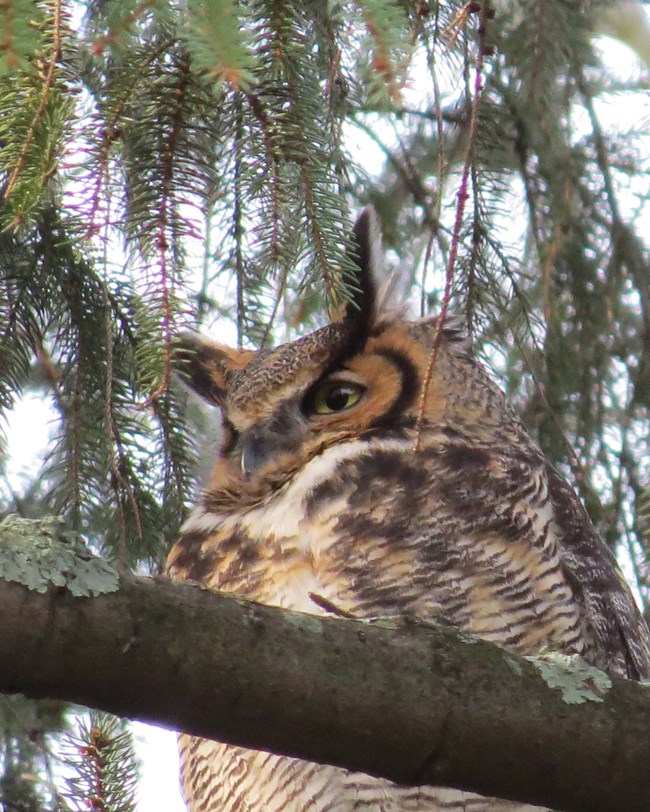
Kathy & Jay Dia Great Horned OwlBubo virginianusIf one bird can set your heart aflutter, it has got to be the Great Horned Owl. Seriously, tell us you would feel anything less than total awe (and a little bit of terror) standing outside the Hartwell Tavern on a cool October evening listening to the haunting hoot of the so-called Tiger Owl. These powerful birds of prey spend their evenings stalking a variety of prey species, from field mice to porcupines. Great Horned Owls have a wide home range in North America; from Nova Scotia, to Mexico, to sub-arctic areas of Alaska. Here in Massachusetts they are also well distributed and are often spotted by the aware birder. This owl nests in coniferous forests, frequently using old nests left behind by large raptors like hawks or eagles. Each year the female will lay 2 to 3 eggs and both male and female will spend several months feeding and teaching the young owlets. For more information on the Great Horned Owl, click here and download a Species Spotlight from the Northeast Temperate Network. 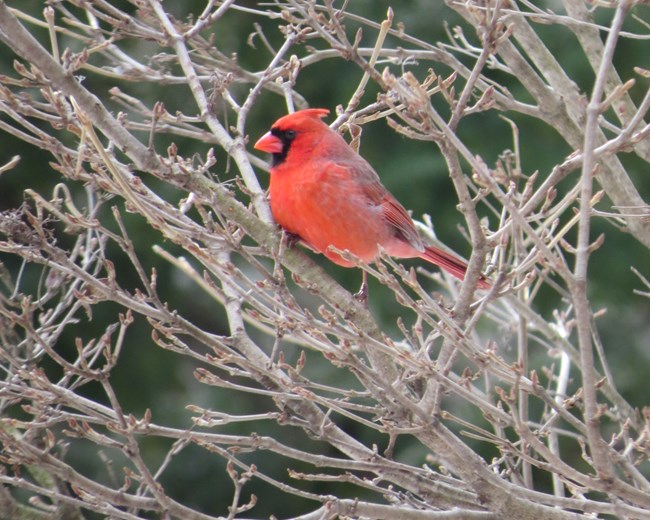
Kathy & Jay Dia Northern CardinalCardinalis cardinalisOne of our favorite birds, the loud and proud Northern Cardinal is a welcome sight within the often-muted landscape of Minute Man National Historical Park. As a year-round residents of Massachusetts, the cardinal will make its home along edges or clearings of forests, as well as more open, developed portions of the park, like the Buttrick gardens. Like many bird species, male and female are fairly easy to differentiate. The male cardinal has bright red feathers with a black mask, while the female has mostly tawny colored feathers with rose to red colored highlights on her head and back. Breeding couples will stay together for multiple seasons and in a deeply cute aspect of their courting ritual, they will sway as they sing to each other. A cardinal couple will brood up to 4 times a year and both male and female take responsibility for the nestlings. 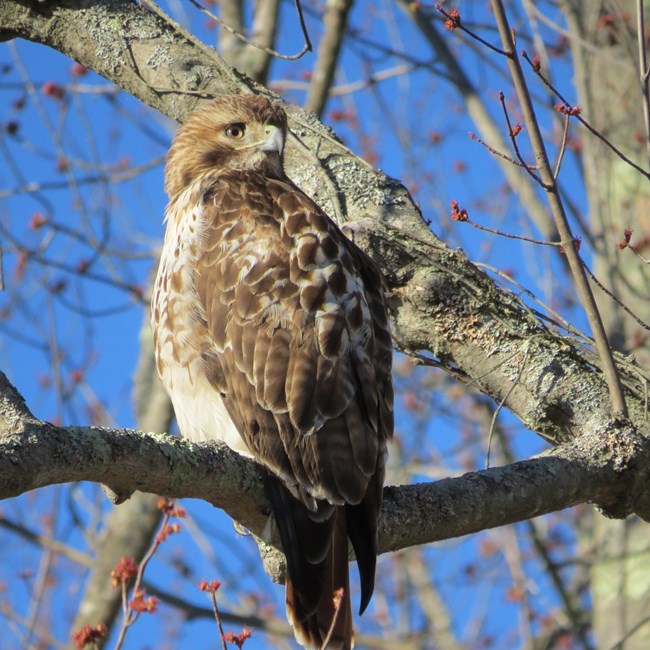
Kathy & Jay Dia Red-Tailed HawkButeo jamaicensisYou can add Hollywood voice over artist to the Red-Tailed Hawk’s long list of skills. When you hear the eerie, raspy screech of a bird of prey on TV and in the movies, it’s often the call of this ravenous raptor… even when it’s an eagle on screen. While we’re not sure whether Red-Tailed Hawks also enjoy reenacting, you can often spot them perched in trees or soaring high above the Battle Road Trail. These year-round residents are comfortable in just about every landscape within the park, from the open farm fields and roadsides where they can hunt for voles and mice, to the forests and developed areas which offer ideal areas to perch and watch before taking off in soaring, looping flight. As part of the courting ritual, male and female hawks perform a sky-high dance, circling and diving around each other. The female lays 2-3 eggs each breeding season and tends to the nestlings while the male takes responsibility for hunting and bringing back dinner. 
Kathy & Jay Dia Rock PigeonColumbia liviaIf you stop by the North Bridge early in the morning, before the crowds and noise arrive, you are likely to encounter a resident group of Rock Pigeons standing sentinel on the rails. Some of our rangers like to believe these members of the dove family are keeping watch over the hallowed grounds before we arrive with our flat hats and badges. Probably not true, but it could be. Pigeons are one of the smartest bird species and have been trained to take on many complex tasks including carrying messages, homing, and racing. One research study even showed pigeons are one of the few birds that can recognize itself in a mirror (you’ll never see one of these guys attacking its reflection in your kitchen window… sorry cardinal). Pigeons mate for life and maintain a cooperative partnership. The female will build the nest with materials supplied by the male and both take turns feeding the young, called squeakers or squabs. While pigeons in urban and suburban areas will eat almost anything, including discarded human junk food, they thrive best on a diet of acorns, worms and seeds. 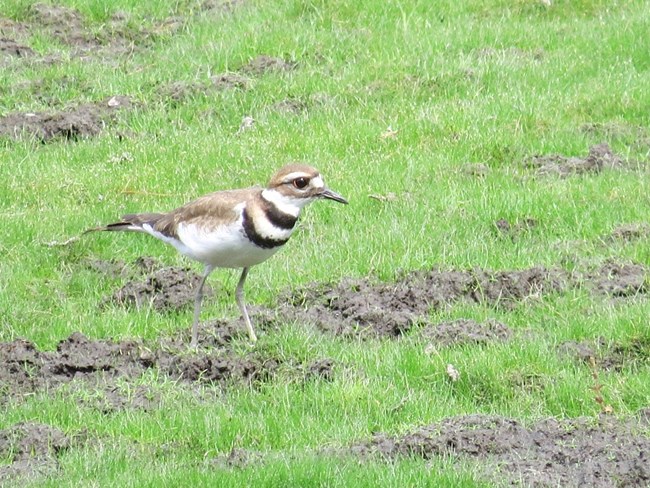
Kathy & Jay Dia KilldeerCharadrius vociferusIt’s a pretty ominous name for such a cute little bird, but don’t worry, the Killdeer did not come by its name by taking down ungulates. This member of the plover family was named for its unique call, “kill-deer, kill-deer, kill-deer.” What’s more, the Killdeer is much more of a defensive player, pretending to have a broken wing to distract predators from its nest. Killdeer nest on the ground in open areas such as farm fields, lawns, airport runways, coastal mudflats and sports fields. These adaptable birds have a wide-ranging diet that includes insects, grubs and snails. Be kind and watch out for these long-legged shorebirds when you see them in the park; while their numbers are currently stable in Massachusetts there have been steep declines in population around many urban areas of the country.
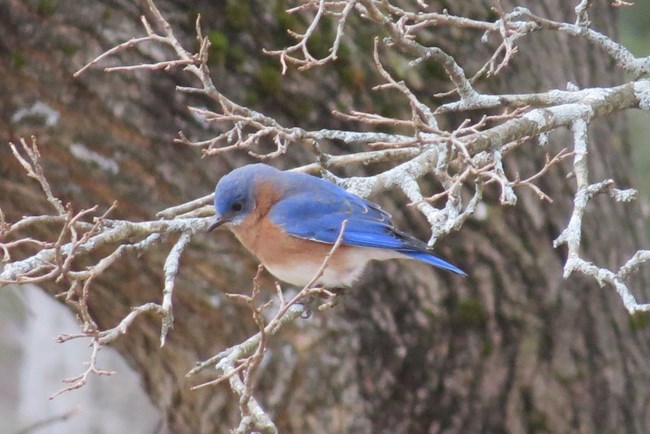
Kathy & Jay Dia Eastern BluebirdSialia sialisDespite what we were taught by several childhood princess movies, we here at Minute Man have never convinced an Eastern Bluebird to help us with chores at the Hartwell Tavern. That said, their sweet musical songs do brighten ones mood when taking on some of the less glamorous tasks of rangering. These little thrushes do live in Massachusetts throughout the year, though they are a rare sight in winter; many choosing to migrate south for the leaner months. Bluebirds prefer more open landscapes with just a few trees, making the pastoral farmland of Middlesex County a perfect place to call home. Their population has been boosted in the last 50 years as many people, concerned with the birds declining numbers in the early 20th century, started putting up bluebird houses in their yards. Bluebirds who don’t take up residence in a house, will nest in hollow trees or cavities left by other species like woodpeckers. Eastern Bluebirds breed 2-3 times a year, laying 4-5 eggs each time. Both parents feed the nestlings. 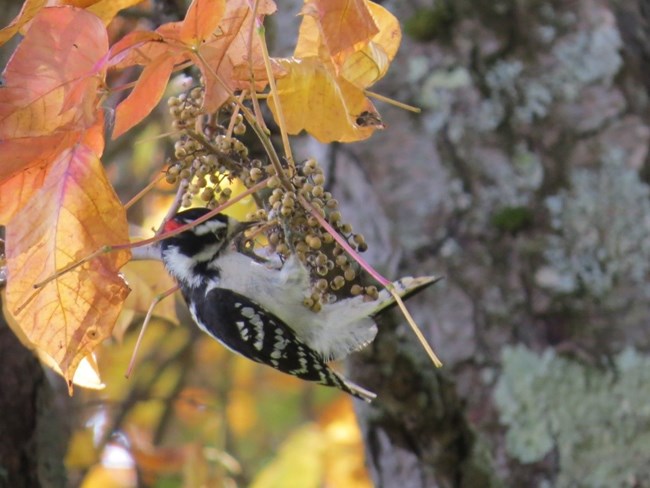
Kathy & Jay Dia Downy WoodpeckerDryobates pubescensThe Downy may be the smallest woodpecker in Massachusetts, but this mighty little bird is highly adaptable and thriving across the state. Named for the light fluffy feathers on its back, super industrious, “Downies” spend a lot of time grasping the branches and trunks of trees with their 3 toes searching out yummy insects. While Downy woodpeckers will live in just about any forested area, they prefer making their nests in deciduous trees. In fact, next time you walk down the Battle Road trail and hear that signature woodpecker drumbeat, know that’s probably what the bird is doing; it can take a Downy woodpecker up to 3 weeks to carve out a nesting cavity. Fun fact, Downy Woodpeckers have special feathers on their beak that help keep bits of bark and wood out of their airway while they hammer away. Once the nest is built, the female will lay 4-5 eggs. Bird Lists And Links
Birding ChecklistVisit the Friends of Minute Man website for a downloadable birding checklist you can take with you and explore the park! Minute Man is also a birding hotspot in the eBird on-line database. Help the park track bird populations and behavior by adding your obsevations to eBird whenever you visit. Learn more about natural resources at Minute Man by visiting the Northeast Temperate Inventory & Monitoring website. You can also help the Natural Resources team at Minute Man study our wildlife populations by participating in a number of non-NPS citizen science initiatives. Read more about them in this article from the National Park Service. |
Last updated: May 26, 2022
